Villa Agnelli and Villa Pesenti is a complex of historical buildings in Forte dei Marmi, Tuscany, Versilia, Italy.
Villa Agnelli and Villa Pesenti is a complex of historical buildings in Forte dei Marmi, Tuscany, Versilia, Italy.
In 1926 Edoardo Agnelli - son of senator Giovanni, founder of the FIAT industry and father of Gianni - bought the neo-Renaissance Villa Costanza, built at the beginning of the '900s by the Admiral Morin, an important figure in Italian military history. The Agnelli family spent their holidays here for more than thirty years, commissioning an underground passage to give direct access to the beach, without having to cross the crowded boulevard. This secret passage remains unique in the Versilian territory.
The bathing establishment, initially, consisted of a tool shed and garage for the family's hydroplane. Today it is one of the most emblematic structures of Forte dei Marmi, preserving the charm that Susanna Agnelli described in her autobiography We always wore sailor suits (1983).
Today, the Villa Agnelli is one of the central areas of the Augustus Hotel & Resort complex, built in the '50s on the foundation of another famous mansion,[ which? ] constructed in the 1930s. The nucleus of the hotel was the Villa Pesenti, a jewel of modern architecture,[ according to whom? ] designed in 1939 by renowned architect Osvaldo Borsani. It is a good example of rationalist architecture, embellished with typical Mediterranean finishes. In 1953 the family added a storey to the Villa, transforming it into the only Luxury Hotel & Resort in Versilia for more than twenty years. Around the main structure, seven villas were built in the following years, by different artists and architects.
Many important artists, actors, sportsmen and prominent cultural figures have spent their vacation in the villas of the Augustus Hotel&Resort: Jimi Hendrix, Charlton Heston, Oriana Fallaci, Eugenio Montale, Francesco Messina, Mario Monicelli, Paul Anka, Vittorio Gassman and many others.

Rimini is a city in the Emilia-Romagna region of northern Italy and capital city of the Province of Rimini. It sprawls along the Adriatic Sea, on the coast between the rivers Marecchia and Ausa. It is one of the most notable seaside resorts in Europe with revenue from both internal and international tourism forming a significant portion of the city's economy. It is also near San Marino, a small nation within Italy. The first bathing establishment opened in 1843. Rimini is an art city with ancient Roman and Renaissance monuments, and is also the birthplace of the film director Federico Fellini.

The province of Lucca is a province in the Tuscany region of Italy. Its capital is the city of Lucca.
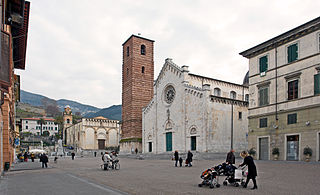
Pietrasanta is a town and comune on the coast of northern Tuscany in Italy, in the province of Lucca. Pietrasanta is part of Versilia, on the last foothills of the Apuan Alps, about 32 kilometres (20 mi) north of Pisa. The town is located 3 kilometres (1.9 mi) off the coast, where the frazione of Marina di Pietrasanta is located.
The Versilia is a part of Tuscany in the north-western province of Lucca and southern part of Massa-Carrara, and is named after the Versilia river. Known for fashionable Riviera resorts, it consists of numerous clubs that are frequented by local celebrities.
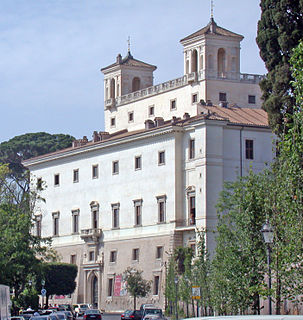
The Villa Medici is a Mannerist villa and an architectural complex with a garden contiguous with the larger Borghese gardens, on the Pincian Hill next to Trinità dei Monti in Rome, Italy. The Villa Medici, founded by Ferdinando I de' Medici, Grand Duke of Tuscany and now property of the French State, has housed the French Academy in Rome since 1803. A musical evocation of its garden fountains features in Ottorino Respighi's Fountains of Rome.

Edoardo Agnelli was an Italian entrepreneur and industrialist and principal family shareholder of the Italian car company Fiat.

Forte dei Marmi is a sea town and comune in the province of Lucca, in northern Tuscany (Italy). It is the birthplace of Paola Ruffo di Calabria, Queen of the Belgians from 1993 to 2013.

Italy has a very broad and diverse architectural style, which cannot be simply classified by period or region, due to Italy's division into various small states until 1861. This has created a highly diverse and eclectic range in architectural designs. Italy is known for its considerable architectural achievements, such as the construction of aqueducts, temples and similar structures during ancient Rome, the founding of the Renaissance architectural movement in the late-14th to 16th century, and being the homeland of Palladianism, a style of construction which inspired movements such as that of Neoclassical architecture, and influenced the designs which noblemen built their country houses all over the world, notably in the United Kingdom, Australia and the United States of America during the late-17th to early 20th centuries.

Foro Italico is a sports complex in Rome, Italy, on the slopes of Monte Mario. It was built between 1928 and 1938 as the Foro Mussolini under the design of Enrico Del Debbio and, later, Luigi Moretti. Inspired by the Roman forums of the imperial age, its design is lauded as a preeminent example of Italian fascist architecture instituted by Mussolini. The purpose of the prestigious project was to get the Olympic Games of 1940 to be organised by fascist Italy and held in Rome.

UNA Hotels & Resorts was an Italian hotel chain with four-star hotels and resorts throughout Italy with more than 3000 rooms. The company also owned a country estate composed of 7 Italian luxury villas. In 2016 UNA Hotels was acquired by UNIPOL Group and merged with Atahotels into Gruppo UNA S.p.A., a new Italian hotel chain.
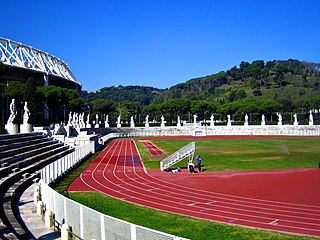
The Stadio dei Marmi is one of four stadiums in the colossal sports complex the Foro Italico, initially named Foro Mussolini. The other stadiums are the Stadio Olimpico, the Stadio del tennis Romano, and the Stadio Olimpico del Nuoto. It was designed in the 1920s as a complement to the annexed Fascist Academy of Physical Education, to be used by its students for training. The Stadio dei Marmi first opened in 1932, on the 10th anniversary of the March on Rome, near the Roman neighborhood Monte Mario, by the architect Enrico Del Debbio under the Fascist ruler Benito Mussolini. The Stadio dei Marmi is encircled by sixty, 4-meter tall classical statues of athletes made from Carrara marble. The stadium was built to celebrate Fascist accomplishments and the Gioventú del Littorio, the youth movement of the National Fascist Party of Italy. In its twenty-year reign, the Fascist regime used sports to introduce and instill new fascist traditions, ideals, customs, and values, with the goal of forming citizen warriors. The Stadio dei Marmi was used to host some of the field hockey preliminaries for the 1960 Summer Olympics and also hosted the opening ceremony for the 2009 World Aquatics Championships.
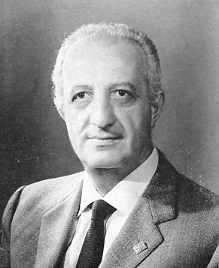
Leonetto Amadei was an Italian lawyer and a politician.
Giorgio Agnelli was a member of the Agnelli family.

Donna Virginia Bourbon del Monte dei principi di San Faustino was the wife of Edoardo Agnelli and the mother of Gianni Agnelli.

Park Eun Sun is a South Korean sculptor.
“La Signorina” Nerina (Nera) Simi was an Italian artist and a teacher of painting and drawing. She was the daughter of the Italian painter Filadelfo (Philadelphus) Simi (1849–1923), himself a student of the French academician Jean-Léon Gérôme (1824–1904).
Bruno Sacchi was an Italian architect and collaborator of Giovanni Michelucci. He is known for his work on the Museo Marino Marini at the former church of San Pancrazio in Florence, the Museo Marino Marini at the TAU Convent in Pistoia, collaborations with Giovanni Michelucci and designs of private houses.
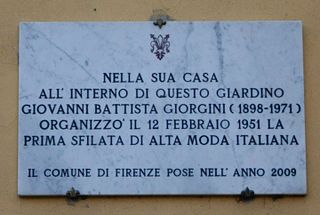
Giovanni Battista Giorgini, nicknamed Bista, was an Italian entrepreneur and member of the Giorgini family.

Villa Pianciani is a complex situated on top of a hill that dominates the Spoleto Valley in Umbria. The complex is the work of architect Giuseppe Valadier and comprises different buildings and a vast historical park. It is one of the most elegant examples of the late 18th century architecture of the region.

Tonfano, originally called ‘Tonfalo’, is one of the four localities in which the frazione of Marina di Pietrasanta is divided, along with Fiumetto, Le Focette and Motrone. The name is derived from that of the river which flowed through the area before it silted up. Tonfano is bordered by Fiumetto to the north and by Motrone to the south.